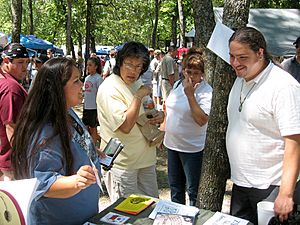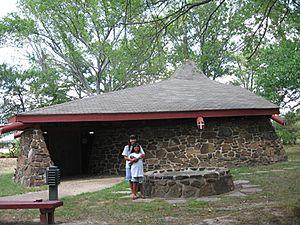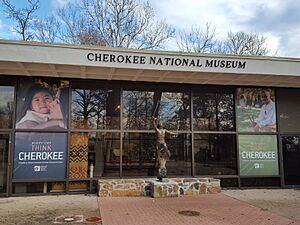Cherokee Heritage Center facts for kids

The Cherokee Heritage Center (in Cherokee: Ꮳꮃꭹ Ꮷꮎꮣꮄꮕꮣ Ꭰᏸꮅ) is a special place. It is a non-profit museum and historical society. Its main goal is to protect and share the history, culture, language, and traditional crafts of the Cherokee people.
This center also has a big database for genealogy. This means you can research your family history if you are Cherokee. The Heritage Center is in Park Hill, Oklahoma, near Tahlequah. It was built close to an old Cherokee Seminary building from the mid-1800s. The Cherokee Nation and the United Keetoowah Band of Cherokee Indians help support it. The center was once called Tsa-La-Gi.
Contents
Discover Cherokee Culture
The Cherokee Heritage Center has many interesting things to see. It holds old documents, art, and cultural items. You can also see relics from the 1830s journey known as the Trail of Tears.
The Cherokee National Museum
Inside the Cherokee National Museum, you will find a large collection of artifacts. These items show Cherokee culture from ancient times to today. It's a great way to learn about their long history.
Explore the Ancient Village
On the center's grounds, there is an amazing Ancient Village. It looks just like a Cherokee town from the mid-1700s. This is how European explorers might have seen it. A guide will take you through the village. You can visit a special seven-sided council house. You will also see a brush arbor. Guides show how people made crafts, hunted, and practiced their traditions. Visitors can even try using a blowgun or playing stickball!
Adams Corner Rural Village
There is also the Adams Corner Rural Village. This area shows what a Cherokee settlement looked like after they moved to Indian Territory.
How the Cherokee Heritage Center Started
The Idea Begins
The Cherokee Heritage Center was founded in 1962. A retired Army Colonel named Marty Hagerstrand started it. He loved researching Cherokee history and culture. Principal Chief of the Cherokee Nation William Wayne Keeler joined him. Chief Keeler wanted to preserve Cherokee culture and heritage.
They believed the center could help the local economy. It would also protect important Cherokee traditions. Colonel Hagerstrand saw the value of the Cherokee people in Tahlequah. Chief Keeler helped him understand it even more. The first newspaper in Oklahoma, the Cherokee Advocate, was published by Cherokees in 1844.
For the first four years, the Heritage Center was in Mr. Hagerstrand's home. In 1966, a plan was made for the buildings. Charles "Chief" Boyd was chosen as the designer.
Research and Planning
Many resources helped plan the center. Northeastern State University had a Cherokee Collection in its library. The Gilcrease Institute in Tulsa also had papers. Reports from the Bureau of American Ethnology of the Smithsonian Institution were useful. Dr. Jack Frederick Kilpatrick, a Cherokee scholar, gave important advice. He helped with planning and building the village. Architect Boyd also studied Cherokee history. He focused on how old buildings looked. His ideas for the ancient village matched what others had thought.
Building the Center
Work on the Heritage Center began on February 23, 1966. Colonel Hagerstrand oversaw the project full-time. He was the General Manager. The Cherokee Foundation helped pay his salary.
The first crew had twelve full-blood Cherokees. They cleared the land. They also found rocks from the old seminary building to use later. Soon, up to 52 Cherokees were working. Village construction started in May 1966. It continued for over a year. Workers used hand tools and native materials. They used old methods to make the village look very real.
A three-month training program started in 1967. It trained 50 to 60 Cherokees. They learned to be village actors and guides. Sequoyah High School helped with this training.
Cherokee artist Cecil Dick advised on planting trees and herbs. These plants were important to Cherokee culture. They were used for medicine, food, building, and tools. The many native plants also attracted animals. The Cherokee Heritage Center grounds became a great place for birdwatching and hiking.
Welcoming Visitors
The village at Tsa-La-Gi opened to the public on June 27, 1967. Over 5,000 people attended the dedication. Society President Keeler led the event. Important officials like Oklahoma Governor Dewey F. Bartlett were there.
Since 1971, the center has hosted the Trail of Tears Art Show every spring. Artists from all tribes can enter. Each fall, the center hosts Cherokee Homecoming. This art show is for artists from the three federally recognized Cherokee tribes.
From 1969 to 2005, an outdoor play was performed. It was called the Trail of Tears. It told the story of the forced removal of the Cherokee people. It also showed their life in Oklahoma. The play was performed in a special outdoor theater.
More to Explore




